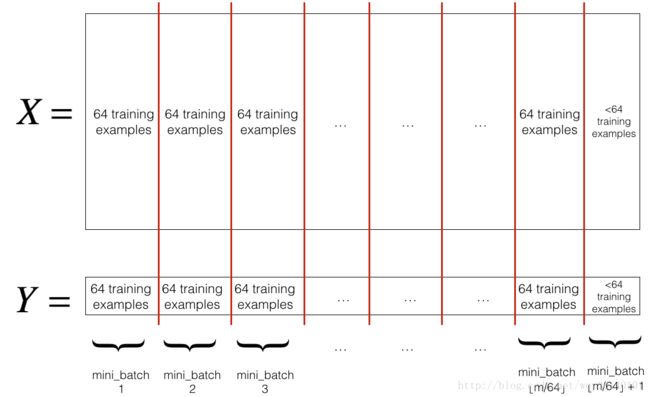深度学习——优化算法
为什么需要优化算法
优化算法可以加快收敛速度(未加入优化的神经网络训练时间比加入优化后时间更短),甚至得到一个更好更小的损失函数值。优化算法能帮你快速高效地训练模型。
有哪些优化算法
- Mini-Batch 梯度下降
- Momentum 动量梯度下降法
- RMSprop
- Adam 提升算法
其中Adam提升算法是Momentum和RMSprop两种相结合的算法,接下来我们会依次介绍这四种算法。
Mini-Batch 梯度下降
算法介绍
训练集被分割为小的子训练集,这些子训练集被称为mini-batch。假设每个子集只有1000个训练数据,那么先取前1000个开始训练(训练方法与梯度下降完全相同,不同的只是对训练集进行了分割),再取接下来的1000个继续训练,依次类推,直到训练完所有的训练数据。以mini-batch为64为例,过程如下图所示:
特别的,当每个mini-batch的大小为1时,得到一种新算法,叫做随机梯度下降,此时每次只取一个样本进行训练,效率过于低下,会失去向量化带来的加速。当mini-batch的大小为训练数据本身时,得到batch梯度下降,也就是我们普通的梯度下降算法(此时损失函数关于迭代次数的图像上,应该是一个持续下降的曲线,如果有上升的情况,那就是学习速率过大)
三种不同mini-batch代码对比
以下代码来自吴恩达coursera《deep learning》课后编程作业
- (Batch) Gradient Descent:
X = data_input
Y = labels
parameters = initialize_parameters(layers_dims)
for i in range(0, num_iterations):
# Forward propagation
a, caches = forward_propagation(X, parameters)
# Compute cost.
cost = compute_cost(a, Y)
# Backward propagation.
grads = backward_propagation(a, caches, parameters)
# Update parameters.
parameters = update_parameters(parameters, grads)
- Stochastic Gradient Descent:
X = data_input
Y = labels
parameters = initialize_parameters(layers_dims)
for i in range(0, num_iterations):
for j in range(0, m):
# Forward propagation
a, caches = forward_propagation(X[:,j], parameters)
# Compute cost
cost = compute_cost(a, Y[:,j])
# Backward propagation
grads = backward_propagation(a, caches, parameters)
# Update parameters.
parameters = update_parameters(parameters, grads)- Mini-batch Gradient Descent:
X = data_input
Y = labels
parameters = initialize_parameters(layers_dims)
for i in range(0, num_iterations):
for minibatch in minibatches:
# Select a minibatch
(minibatch_X, minibatch_Y) = minibatch
# Forward propagation
a3, caches = forward_propagation(minibatch_X, parameters)
# Compute cost
cost = compute_cost(a3, minibatch_Y)
# Backward propagation
grads = backward_propagation(minibatch_X, minibatch_Y, caches)
# Update parameters.
parameters = update_parameters_with_gd(parameters, grads, learning_rate)所以,我们的目标是找一个大小适中的mini-batch。
mini-batch选取数据集代码实现
# GRADED FUNCTION: random_mini_batches
def random_mini_batches(X, Y, mini_batch_size = 64, seed = 0):
"""
Creates a list of random minibatches from (X, Y)
Arguments:
X -- input data, of shape (input size, number of examples)
Y -- true "label" vector (1 for blue dot / 0 for red dot), of shape (1, number of examples)
mini_batch_size -- size of the mini-batches, integer
Returns:
mini_batches -- list of synchronous (mini_batch_X, mini_batch_Y)
"""
np.random.seed(seed) # To make your "random" minibatches the same as ours
m = X.shape[1] # number of training examples
mini_batches = []
# Step 1: Shuffle (X, Y)
permutation = list(np.random.permutation(m))
shuffled_X = X[:, permutation]
shuffled_Y = Y[:, permutation].reshape((1,m))
# Step 2: Partition (shuffled_X, shuffled_Y). Minus the end case.
num_complete_minibatches = math.floor(m/mini_batch_size) # number of mini batches of size mini_batch_size in your partitionning
for k in range(0, num_complete_minibatches):
mini_batch_X = shuffled_X[:, mini_batch_size*k : mini_batch_size*(k+1)]
mini_batch_Y = shuffled_Y[:, mini_batch_size*k : mini_batch_size*(k+1)]
mini_batch = (mini_batch_X, mini_batch_Y)
mini_batches.append(mini_batch)
# Handling the end case (last mini-batch < mini_batch_size)
if m % mini_batch_size != 0:
mini_batch_X = shuffled_X[:, mini_batch_size*num_complete_minibatches : m]
mini_batch_Y = shuffled_Y[:, mini_batch_size*num_complete_minibatches : m]
mini_batch = (mini_batch_X, mini_batch_Y)
mini_batches.append(mini_batch)
return mini_batchesMomentum 动量梯度下降法
算法介绍
由于Mini-batch梯度下降使用数据子集进行参数更新,所以更新的方向跟普通的batch梯度下降有些不同,而是有一些变化(这里是指,不同的数据子集在进行梯度下降时,可能使损失函数值上升,但总趋势是下降的),因此小批量梯度下降的路径将会“震荡”到收敛。使用动量可以减少震荡。这些“变化“形象化表示如下:

动量梯度下降的公式如下:
其中 β 是动量,一般设置为0.9, α 是学习速率。该公式蕴含这一种思想——指数加权平均。这里我不过多地从数学角度解释为什么这样,一个我个人认为易于理解的解释是,这种表达从图形化的角度来看,是把过去的梯度下降考虑在内来平滑当下的梯度变化,从而减小垂直方向上的震荡,同时保持水平方向上的下降速度。

代码实现
def update_parameters_with_momentum(parameters, grads, v, beta, learning_rate):
"""
Update parameters using Momentum
Arguments:
parameters -- python dictionary containing your parameters:
parameters['W' + str(l)] = Wl
parameters['b' + str(l)] = bl
grads -- python dictionary containing your gradients for each parameters:
grads['dW' + str(l)] = dWl
grads['db' + str(l)] = dbl
v -- python dictionary containing the current velocity:
v['dW' + str(l)] = ...
v['db' + str(l)] = ...
beta -- the momentum hyperparameter, scalar
learning_rate -- the learning rate, scalar
Returns:
parameters -- python dictionary containing your updated parameters
v -- python dictionary containing your updated velocities
"""
L = len(parameters) // 2 # number of layers in the neural networks
# Momentum update for each parameter
for l in range(L):
# compute velocities
v["dW" + str(l+1)] = beta*v["dW" + str(l+1)]+(1-beta)*grads["dW" + str(l+1)]
v["db" + str(l+1)] =beta*v["db" + str(l+1)]+(1-beta)*grads["db" + str(l+1)]
# update parameters
parameters["W" + str(l+1)] = parameters["W" + str(l+1)]-learning_rate*v["dW" + str(l+1)]
parameters["b" + str(l+1)] = parameters["b" + str(l+1)]-learning_rate*v["db" + str(l+1)]
return parameters, vRMSprop算法
算法介绍
与前一个算法的目的相同,我们想减少纵轴上的震荡,同时增大横纵上的收敛速度。我们推出跟前一个类似的公式:
Adam算法
该算法是前两种算法的结合版本。公式如下:
- L is the number of layers
- β1 and β2 are hyperparameters that control the two exponentially weighted averages. 一般来说 β1 =0.9 β2 =0.999我们的目标不是来调整这两个参数的。
- α is the learning rate
- ε is a very small number to avoid dividing by zero 一般设为 10−8
Adam更新参数的代码
def update_parameters_with_adam(parameters, grads, v, s, t, learning_rate = 0.01,
beta1 = 0.9, beta2 = 0.999, epsilon = 1e-8):
"""
Update parameters using Adam
Arguments:
parameters -- python dictionary containing your parameters:
parameters['W' + str(l)] = Wl
parameters['b' + str(l)] = bl
grads -- python dictionary containing your gradients for each parameters:
grads['dW' + str(l)] = dWl
grads['db' + str(l)] = dbl
v -- Adam variable, moving average of the first gradient, python dictionary
s -- Adam variable, moving average of the squared gradient, python dictionary
learning_rate -- the learning rate, scalar.
beta1 -- Exponential decay hyperparameter for the first moment estimates
beta2 -- Exponential decay hyperparameter for the second moment estimates
epsilon -- hyperparameter preventing division by zero in Adam updates
Returns:
parameters -- python dictionary containing your updated parameters
v -- Adam variable, moving average of the first gradient, python dictionary
s -- Adam variable, moving average of the squared gradient, python dictionary
"""
L = len(parameters) // 2 # number of layers in the neural networks
v_corrected = {} # Initializing first moment estimate, python dictionary
s_corrected = {} # Initializing second moment estimate, python dictionary
# Perform Adam update on all parameters
for l in range(L):
# Moving average of the gradients. Inputs: "v, grads, beta1". Output: "v".
v["dW" + str(l+1)] = beta1*v["dW" + str(l+1)]+(1-beta1)*grads["dW" + str(l+1)]
v["db" + str(l+1)] = beta1*v["db" + str(l+1)]+(1-beta1)*grads["db" + str(l+1)]
# Compute bias-corrected first moment estimate. Inputs: "v, beta1, t". Output: "v_corrected".
### START CODE HERE ### (approx. 2 lines)
v_corrected["dW" + str(l+1)] = v["dW" + str(l+1)]/(1-np.power(beta1,t))
v_corrected["db" + str(l+1)] = v["db" + str(l+1)]/(1-np.power(beta1,t))
# Moving average of the squared gradients. Inputs: "s, grads, beta2". Output: "s".
s["dW" + str(l+1)] = beta2*s["dW" + str(l+1)]+(1-beta2)*grads["dW" + str(l+1)]*grads["dW" + str(l+1)]
s["db" + str(l+1)] =beta2*s["db" + str(l+1)]+(1-beta2)*grads["db" + str(l+1)]*grads["db" + str(l+1)]
# Compute bias-corrected second raw moment estimate. Inputs: "s, beta2, t". Output: "s_corrected".
s_corrected["dW" + str(l+1)] = s["dW" + str(l+1)]/(1-np.power(beta2,t))
s_corrected["db" + str(l+1)] = s["db" + str(l+1)]/(1-np.power(beta2,t))
# Update parameters. Inputs: "parameters, learning_rate, v_corrected, s_corrected, epsilon". Output: "parameters".
parameters["W" + str(l+1)] = parameters["W"+str(l+1)]-learning_rate*v_corrected["dW"+str(l+1)]/(np.sqrt(s_corrected["dW"+str(l+1)])+epsilon)
parameters["b" + str(l+1)] = parameters["b"+str(l+1)]-learning_rate*v_corrected["db"+str(l+1)]/(np.sqrt(s_corrected["db"+str(l+1)])+epsilon)
return parameters, v, s总结
动量下降通常是有帮助的,但是如果使用了小的学习速率和简单的数据集,它的影响微乎其微。Adma的内存需求较低,工作性能也很好。实际中我们常用这种作为调优方式。